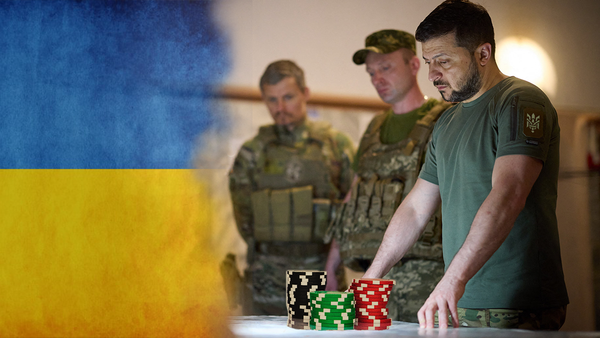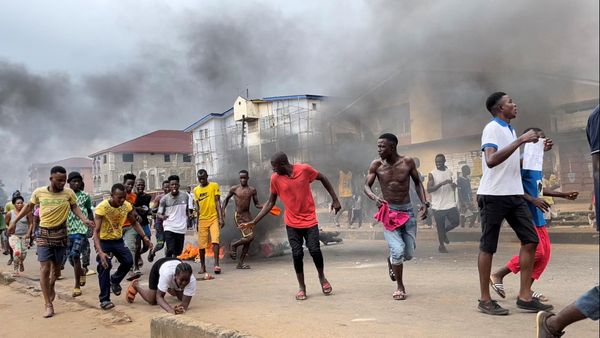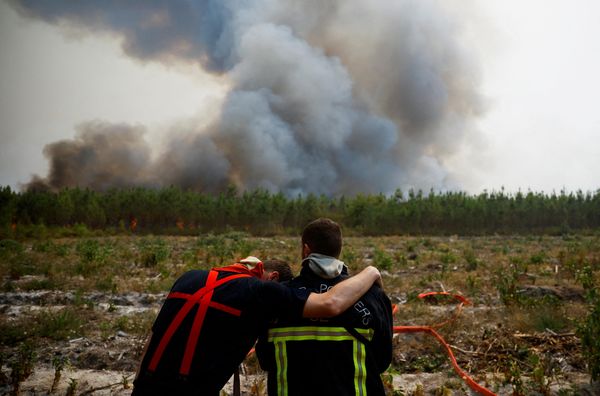Today, we mark a potential turning point in Ukraine, track a Baltic backhand for China, fill the American tank, and take cover in Sierra Leone. We’ve also got your quiz! Thank you very much for reading Signal. -Willis Sparks
|
|
|
Today, we mark a potential turning point in Ukraine, track a Baltic backhand for China, fill the American tank, and take cover in Sierra Leone. We’ve also got your quiz! Thank you very much for reading Signal. -Willis Sparks

During a speech on Wednesday, Ukraine’s President Volodymyr Zelensky made a striking statement: “This Russian war … began with Crimea and must end with Crimea — with its liberation.” He added a bold prediction: “I know we will return to the Ukrainian Crimea.” In the process, Zelensky has defined victory not just as the erasure of Russia’s territorial gains since the invasion began on February 24; he’s said victory demands the eviction of Russian troops and civilians from the Crimean Peninsula, which Russia has controlled since 2014. And he says victory will be achieved.
Zelensky’s statement would be easier to dismiss as empty bravado were it not for the startling series of explosions that inflicted major damage on a Russian military airfield in Crimea just hours earlier. Later comments from Ukrainian officials have marked this moment as the beginning of a major new counteroffensive in southern Ukraine that they believe “could decide the outcome of the next phase of the war,” according to the Washington-based Institute for the Study of War. At times since the invasion, Zelensky has signaled he’s willing to offer concessions on important issues, including territory, to reach a ceasefire with Russia. This new direction raises a basic question for the future of the war: Why has Zelensky insisted that victory must include the recapture of Crimea? Here are three possible answers. - He believes it. He considers the retaking of Crimea both necessary and achievable. The arrival of US weapons and promises of more have persuaded him that Ukraine is about to deal Russia some heavy battlefield blows. Financial help from Europe bolsters his confidence that Ukraine can keep the lights on and finance its war effort.
- He’s just projecting confidence for Ukraine’s foreign backers. Zelensky knows that no one wants to spend precious resources on a lost cause. Future US and European military and financial support depend on confidence that Ukraine can survive. With a show of confidence that Ukraine is about to go on the offense, he hopes to bolster foreign faith in his country’s capabilities
- He’s just projecting confidence for exhausted and demoralized civilians and troops. Since Ukrainian forces scored early victories that repelled Russia’s early bid to seize Kyiv, Russia’s grinding advance in the country’s east has kept Ukraine on the defensive. Aware that Ukrainians don’t want to give Russia any territorial concessions, Zelensky wants to boost their confidence and persuade them he won’t trade land for peace.
The answer could be some combination of all three. But Zelensky’s bold statement also poses three risks for Ukraine. - He might push Russia to raise the stakes. Vladimir Putin now considers Crimea part of Russia, even if most of the world refuses to recognize this eight-year-old claim, and the seizure of Crimea won Putin a legacy-defining accomplishment and a big popularity boost at home. Any attempt to evict Russia will provoke Putin to find (potentially explosive) new ways to punish Ukraine and all who support it.
- As a result, Ukraine’s foreign allies, eager to limit the scope of this war, might pump the brakes. US and European public comments aren’t likely to change, but they may well be warning Zelensky privately that his goal is not achievable and will harm the larger war effort.
- Zelensky could inadvertently set up his own people for a disillusioning end of the war. By insisting there is no victory without the recapture of Crimea, Zelensky is setting a bar he might not clear. Crucially, that might make it much harder to sell the Ukrainian people on an otherwise good deal to end the war and protect Ukraine’s future.
Zelensky’s comments and the damage to Russia’s military airbase inside Crimea have now put the ball squarely in Putin’s court, but Ukraine’s beleaguered people and their Western allies will be watching closely to see what Ukraine’s president says next.
For months, Ukraine has been resisting the Russian invasion in no small part due to a steady supply of arms from Western nations, led by the US and its NATO allies. This includes long-range weapons, which allow the Ukrainians to strike Russian targets from a distance — crucial to keeping enemy forces away and stalling their advance. But the West has also been careful to avoid giving Ukraine its most high-tech toys, wary that it might push the Russians to escalate and perhaps even go nuclear. Still, Kyiv's arsenal is definitely a match for Moscow's. We look at the most effective long-range weapons supplied to Ukraine by the West.
Central banks are considering whether a Central Bank Digital Currency, or CBDC, makes sense for their economies. This report by the Visa Economic Empowerment Institute explores some of the motivations leading central banks on this journey, examines the policy implications of building different types of CBDC, and poses a series of questions for policymakers to consider.

Fracas in Freetown
Sierra Leone on Thursday declared a nationwide curfew and cut access to the internet by 95% amid deadly anti-government protests over inflation. Six cops and 21 civilians have been killed in the West African nation, where about half the population lives under the poverty line. Most Sierra Leonians are struggling to meet their basic needs due to high food and fuel prices, which have jumped 40% in recent months, mainly due to the effect of Russia’s war in Ukraine on global commodities. Such unrest is unusual in Sierra Leone, which has been relatively peaceful and politically stable since its civil war 20 years ago. More broadly, in recent weeks similar protests over the cost of living have also turned deadly across the continent in Ghana, Kenya, and South Africa. So far the demonstrations have yet to topple an African government, many of which are mired in debt and simply don’t have the cash to offer relief to their citizens. But if food and fuel prices continue to climb, so will levels of civilian desperation.
Americans get some reprieve at the pump We’ve been talking about prices at the pump a lot in recent months, and for very good reason. But after months of eye-watering prices, the average cost of gasoline in the US has fallen below $4 a gallon for the first time since March, according to AAA, a roadside assistance motor club. This marks a 20% drop from mid-June when prices exceeded $5, suggesting that the US Fed’s efforts to curb inflation are having an impact. Oil prices in the US – and globally – have also dropped in recent weeks amid fears of a global recession as the war in Ukraine lingers. What’s more, 88% of Americans recently surveyed said they were driving less due to high gas prices, indicating that slumping demand is fueling lower prices. With the cost-of-living dominating US political discourse, President Joe Biden and the Democrats are heralding the price drop to showcase their efforts to address inflation ahead of November’s midterms. This follows a slate of recent legislative wins for the Dems – can they maintain the momentum? China’s “no limits” gets no love in Baltics
Latvia and Estonia have announced they are ditching a grouping of central and eastern European countries that are meant to be deepening economic ties with Beijing. The reason? The friend of their enemy is not their friend: the two countries say they can’t accept being a partner of China’s so long as Beijing maintains a “no limits friendship” with Russia, the Baltics’ much-resented former colonial overlord. The Latvian and Estonian exit from the group follows fellow Baltic country Lithuania’s departure last year after a spat with China over deepening ties with Taiwan. The grouping, formerly known as 17+1 (for the number of European countries plus China), is now down to a skinnier 14. Although the Baltics’ combined GDP of a little more than $140 billion is about 100 times smaller than China’s, their decision to ditch the club opens the question of whether more formidable economies in the region — such as Poland — may follow suit. Both sides will need to pick their friends wisely.
Fingers on buzzers. Have you stayed on top of international politics this week? Prove it with our weekly news quiz.

10,000: Out-of-control blazes on the outskirts of Bordeaux in southwest France have caused 10,000 people to flee their homes. Dubbed a “monster” wildfire by emergency services, this comes amid a hellish summer in France, where fires have already destroyed thousands of acres of forestry.
14: Sweden has agreed to extradite a Turkish national – previously sentenced to 14 years in prison – who is wanted by Ankara for bank fraud. Indeed, it’s the first such extradition between the two states since Ankara agreed to let Stockholm formally apply for NATO membership on the condition that Sweden hands over at least some alleged terrorists residing in Sweden. 300: The recent resumption of grain exports from Ukraine’s Black Sea port was hailed as a big victory by the UN. But the organization is now turning its attention to the “enormous” fertilizer shortage. Across much of import-reliant Africa, fertilizer prices have shot up 300% since Russia’s invasion of Ukraine, causing steep drops in food production at a time when global food prices are sky-high. 10: Monkeypox is spreading globally, and the World Health Organization has issued a stark warning: Stop hurting the monkeys! This comes after at least 10 of the animals were recently abused or killed in Brazil, which has reported more than 2,000 cases of the disease.
Words of wisdom “In summer, the song sings itself.” ― William Carlos Williams This edition of Signal was written by Gabrielle Debinski, Alex Kliment, Carlos Santamaria, and Willis Sparks. Edited by Tracy Moran. Graphic by Luisa Vieira. Art by Paige Fusco.
|
|
|
|